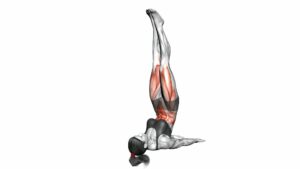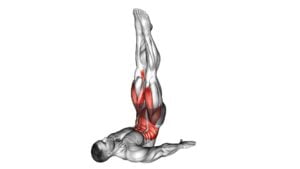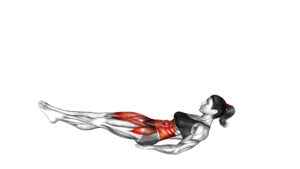Lying Alternate Bent Leg Raise (female) – Video Exercise Guide & Tips

Get ready to tone your legs with the lying alternate bent leg raise!
Watch This Exercise Video
In this video exercise guide, we'll show you the proper form and technique for females. Whether you're a beginner or advanced, we've got modifications for you.
Avoid common mistakes and maximize your results with our helpful tips.
So grab a mat, hit play, and let's get those legs looking strong and sculpted!
Key Takeaways
- Lying Alternate Bent Leg Raise is effective for strengthening the core and improving hip flexibility.
- It targets the lower abdominal muscles for building core strength and stability.
- Proper form and technique include lying flat on the back, engaging the core, and lifting one leg at a time towards the chest.
- Modifications for beginners and advanced levels can be made to increase or decrease difficulty.
Benefits of Lying Alternate Bent Leg Raise
To fully understand the benefits of the lying alternate bent leg raise, you should know that it's an effective exercise for strengthening your core and improving hip flexibility.
This exercise specifically targets your lower abdominal muscles, helping to build core strength and stability. By lying on your back with your legs bent and feet flat on the ground, you can engage your core muscles to lift one leg at a time towards your chest.
This motion activates your lower abdominal muscles, helping to tone and strengthen them. Additionally, as you raise your leg, you also stretch and improve the flexibility in your hips. This can be especially beneficial for individuals who sit for long periods or have tight hip muscles.
Proper Form and Technique for Females
Now let's delve into the proper form and technique for females when performing the lying alternate bent leg raise. As a woman engaging in strength training and female fitness, it's important to ensure you're executing this exercise correctly to maximize its benefits.
Here's a breakdown of the proper form and technique for females:
- Lie flat on your back on a mat or exercise bench.
- Bend both knees and place your feet flat on the ground, hip-width apart.
- Keep your arms relaxed by your sides, palms facing down.
- Engage your core and maintain a neutral spine throughout the exercise.
- Lift one leg off the ground, bending it at a 90-degree angle, while keeping the other leg grounded.
- Slowly lower the lifted leg back down to the starting position.
- Repeat the movement with the opposite leg.
- Continue alternating legs while maintaining control and stability.
Remember, it's crucial to focus on the mind-muscle connection and engage your abdominal muscles throughout the exercise. By following these proper form and technique guidelines, you can effectively target your core and strengthen your lower body.
Incorporate this exercise into your strength training routine for optimal results in female fitness.
Modifications for Beginners and Advanced Levels
To make this exercise more accessible for beginners, you can start by bending your knees at a smaller angle, such as 45 degrees, instead of the full 90 degrees. This will reduce the strain on your lower back and make it easier to lift your legs off the ground. You can also place your hands under your hips for added support. As you get stronger, you can gradually increase the angle of your knee bend and decrease the support from your hands.
For advanced modifications, you can try straightening your legs and raising them higher off the ground. This will engage your core muscles even more and provide a greater challenge. You can also add ankle weights or hold a dumbbell between your feet to increase the resistance. Another option is to perform the exercise on an incline bench, which will further target your lower abs.
Remember to always listen to your body and only progress to more advanced modifications when you feel comfortable and confident with the exercise. It's important to maintain proper form throughout to avoid injury and get the most out of your workout.
Common Mistakes to Avoid
Avoiding common mistakes is crucial when performing the lying alternate bent leg raise exercise. To ensure you're using proper technique, be mindful of the following common mistakes:
- Lifting your head and neck: It's easy to strain your neck and lose focus on your core when you lift your head off the ground. Keep your head relaxed and in line with your spine throughout the exercise.
- Rushing the movement: Moving too quickly can compromise the effectiveness of the exercise. Take your time and focus on maintaining control and stability throughout each repetition.
- Not engaging your core: This exercise is designed to target your abdominal muscles, so it's important to actively engage your core throughout the movement. Keep your abdominal muscles tight and your lower back pressed firmly against the ground.
By avoiding these common mistakes and maintaining proper technique, you'll maximize the benefits of the lying alternate bent leg raise exercise. Remember to always listen to your body and make adjustments as needed.
Happy exercising!
Tips for Maximizing Results
To maximize your results with the lying alternate bent leg raise exercise, it's important to incorporate these helpful tips.
First, let's address some common misconceptions. One common mistake is thinking that lifting your legs higher will automatically make the exercise more effective. However, the key is to focus on proper form and control rather than height. Make sure to keep your core engaged and your lower back pressed firmly against the ground throughout the movement.
Another misconception is that this exercise only targets the lower abs. While it does primarily work the lower abs, it also engages the hip flexors and obliques. To fully maximize your results, it's important to engage all of these muscles by maintaining proper form and control.
Now, let's talk about effective variations of the lying alternate bent leg raise. One variation is the straight leg raise, where you keep your legs straight instead of bending them. This variation increases the intensity and puts more emphasis on the lower abs.
Another variation is the double leg raise, where you lift both legs simultaneously. This variation challenges your core even more and can help build overall abdominal strength.
Incorporating these tips and variations into your lying alternate bent leg raise routine will help you maximize your results and achieve a stronger, more defined core. Keep practicing and stay consistent for the best outcomes.
Frequently Asked Questions
How Many Sets and Repetitions Should I Do for the Lying Alternate Bent Leg Raise Exercise?
To determine how many sets and repetitions to do for the lying alternate bent leg raise exercise, it's important to consider different variations and proper form. Start by focusing on maintaining proper technique, keeping your core engaged and your back flat on the ground.
As for the sets and repetitions, it's best to start with 2-3 sets of 10-12 repetitions and gradually increase as you get stronger. Remember to listen to your body and adjust accordingly.
Can Men Also Perform the Lying Alternate Bent Leg Raise Exercise?
Yes, men can definitely perform the lying alternate bent leg raise exercise. It's a great way to strengthen your core and lower body.
To make modifications for men, you can increase the difficulty by adding ankle weights or using a stability ball. If you're a beginner, you can start by doing fewer repetitions and gradually increase as you get stronger.
Remember to maintain proper form and engage your core throughout the exercise.
Is It Necessary to Use Ankle Weights While Performing the Lying Alternate Bent Leg Raise Exercise?
Using ankle weights for the lying alternate bent leg raise exercise has its pros and cons.
On one hand, it can increase the intensity of the exercise and target your leg muscles more effectively.
However, it may also put additional strain on your joints and increase the risk of injury.
If you're a beginner, it's recommended to start without ankle weights and gradually add them as you build strength.
Can I Do This Exercise if I Have Lower Back Pain?
Yes, you can still do the lying alternate bent leg raise exercise even if you have lower back pain. However, it's important to modify the exercise to avoid exacerbating your pain.
Try using a smaller range of motion and keeping your lower back supported by placing a rolled-up towel under it.
Additionally, it would be beneficial to incorporate stretching and strengthening exercises for your lower back before attempting this exercise to alleviate any discomfort.
How Long Should I Hold the Raised Leg Position During the Lying Alternate Bent Leg Raise Exercise?
When doing the lying alternate bent leg raise, you might wonder how long to hold the raised leg position. The duration of holding the position can vary depending on your fitness level and goals.
Generally, it's recommended to hold the raised leg position for a few seconds before lowering it back down. However, you can challenge yourself by holding it for longer or incorporating variations like adding ankle weights.
Experiment and find what works best for you!
Conclusion
In conclusion, the lying alternate bent leg raise is a beneficial exercise for females, targeting the core and hip muscles. By maintaining proper form and technique, beginners and advanced individuals can reap the rewards of this exercise.
Avoiding common mistakes and following the provided tips will help maximize results. Incorporate this exercise into your fitness routine to strengthen and tone your lower body effectively.

Author
Years ago, the spark of my life’s passion ignited in my mind the moment I stepped into the local gym for the first time. The inaugural bead of perspiration, the initial endeavor, the very first surge of endorphins, and a sense of pride that washed over me post-workout marked the beginning of my deep-seated interest in strength sports, fitness, and sports nutrition. This very curiosity blossomed rapidly into a profound fascination, propelling me to earn a Master’s degree in Physical Education from the Academy of Physical Education in Krakow, followed by a Sports Manager diploma from the Jagiellonian University. My journey of growth led me to gain more specialized qualifications, such as being a certified personal trainer with a focus on sports dietetics, a lifeguard, and an instructor for wellness and corrective gymnastics. Theoretical knowledge paired seamlessly with practical experience, reinforcing my belief that the transformation of individuals under my guidance was also a reflection of my personal growth. This belief holds true even today. Each day, I strive to push the boundaries and explore new realms. These realms gently elevate me to greater heights. The unique combination of passion for my field and the continuous quest for growth fuels my drive to break new ground.







